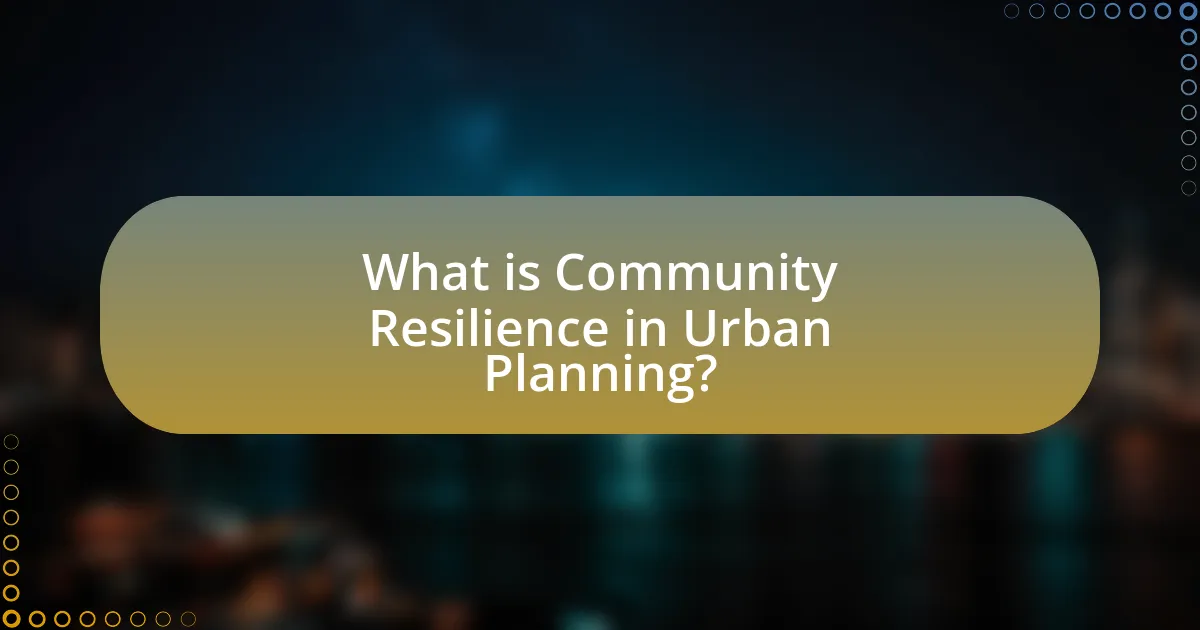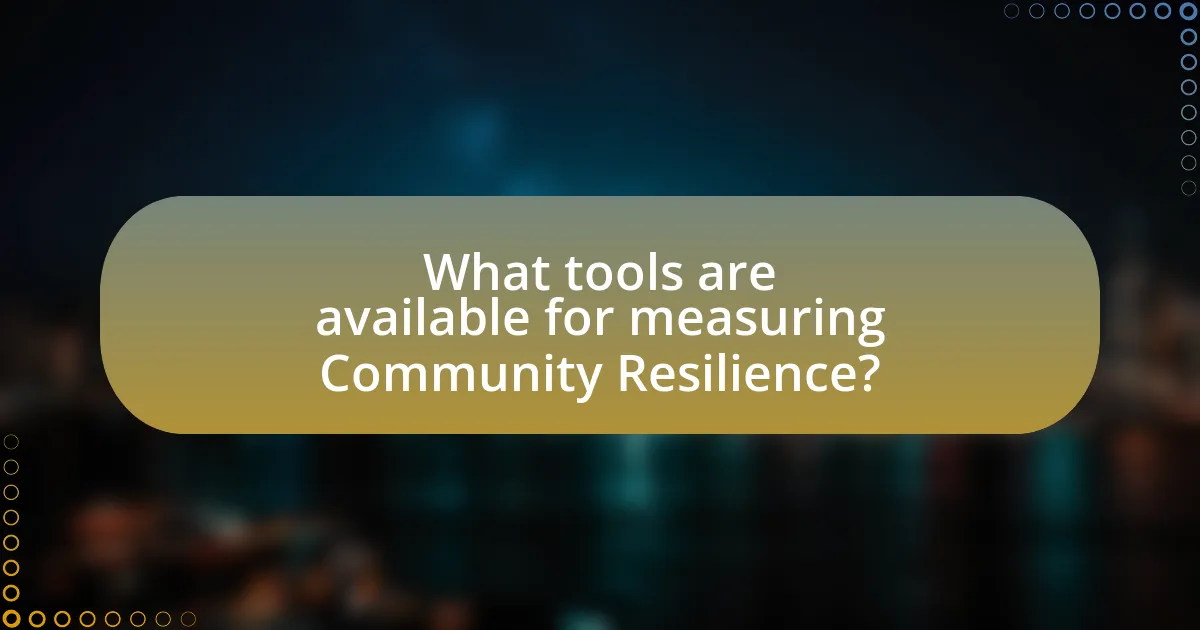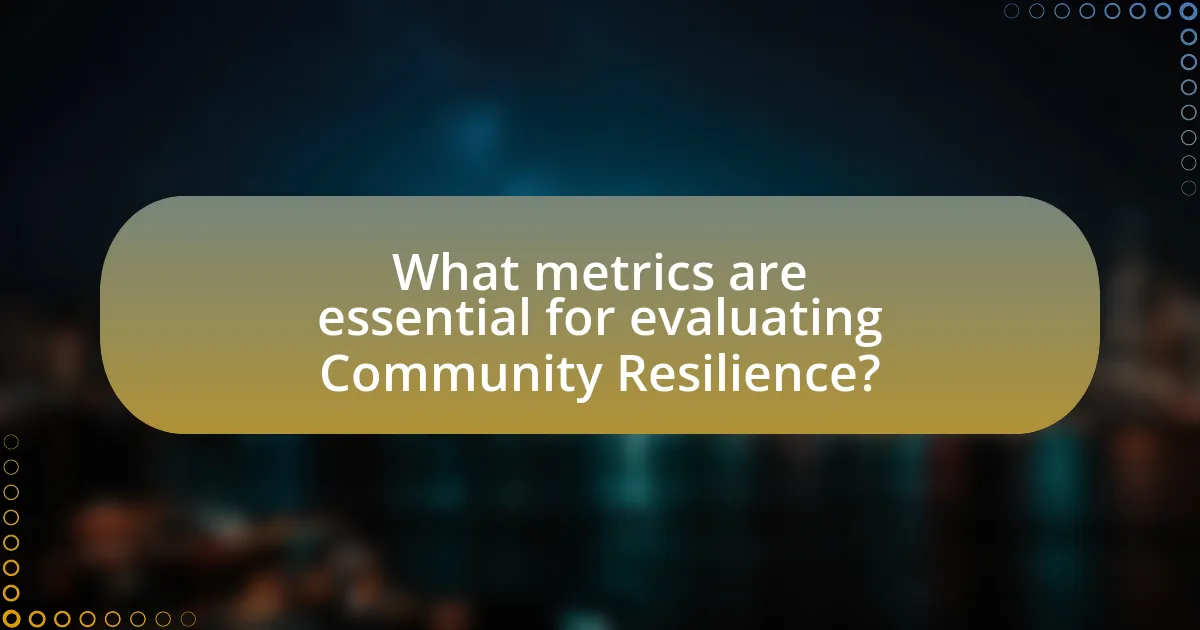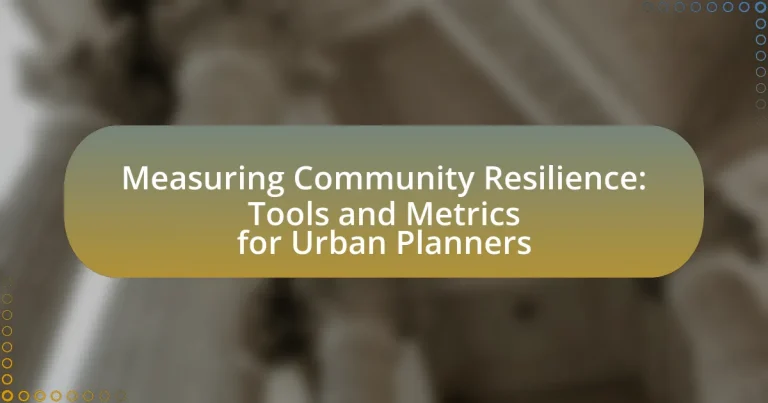Community resilience in urban planning is defined as the capacity of a community to prepare for, respond to, and recover from adverse events while maintaining essential functions. This article explores the significance of community resilience, highlighting key characteristics such as strong social networks, effective governance, and robust infrastructure. It discusses the challenges of measuring resilience, the influence of socio-economic factors, and the role of environmental sustainability. Additionally, various tools and metrics for assessing resilience, including quantitative and qualitative methods, are examined, along with best practices for urban planners to enhance community resilience through stakeholder engagement and adaptive management strategies.

What is Community Resilience in Urban Planning?
Community resilience in urban planning refers to the ability of a community to prepare for, respond to, and recover from adverse events, such as natural disasters or economic shocks. This concept emphasizes the importance of adaptive capacity, social cohesion, and resource management in enhancing a community’s overall stability and sustainability. Research indicates that communities with strong social networks and effective governance structures are better equipped to withstand and recover from crises, as evidenced by studies showing that neighborhoods with active community organizations experienced faster recovery after disasters.
How is Community Resilience defined in the context of urban environments?
Community resilience in urban environments is defined as the ability of a community to prepare for, respond to, and recover from adverse events while maintaining essential functions and structures. This concept encompasses various dimensions, including social, economic, and infrastructural aspects, which collectively enhance a community’s capacity to withstand shocks such as natural disasters, economic downturns, or public health crises. Research indicates that urban areas with strong social networks, effective governance, and adaptive infrastructure are better positioned to achieve resilience, as evidenced by studies showing that communities with robust social ties recover more quickly from disasters (Aldrich, 2012, “Building Resilience: Social Capital in Post-Disaster Recovery”).
What are the key characteristics of a resilient community?
A resilient community is characterized by its ability to adapt, recover, and thrive in the face of challenges and disruptions. Key characteristics include strong social networks, effective governance, diverse economic opportunities, and robust infrastructure. Strong social networks foster collaboration and support among residents, enhancing community cohesion. Effective governance ensures that decision-making processes are inclusive and responsive to community needs, which is crucial during crises. Diverse economic opportunities provide stability and reduce vulnerability to economic shocks, while robust infrastructure, including transportation and utilities, ensures that essential services remain operational during emergencies. These characteristics collectively enable a community to withstand and recover from adverse events, as evidenced by studies showing that communities with these traits experience quicker recovery times and improved overall well-being.
Why is Community Resilience important for urban planners?
Community resilience is important for urban planners because it enhances the ability of communities to withstand and recover from adverse events, such as natural disasters or economic downturns. Urban planners utilize resilience metrics to assess vulnerabilities and strengths within communities, enabling them to design infrastructure and policies that promote sustainability and adaptability. For instance, studies show that cities with higher resilience scores can recover more quickly from disasters, reducing economic losses and improving quality of life for residents. This focus on resilience ultimately leads to more robust urban environments that can better support their populations in times of crisis.
What are the main challenges in measuring Community Resilience?
The main challenges in measuring Community Resilience include the complexity of defining resilience, the variability of community contexts, and the lack of standardized metrics. Defining resilience is difficult because it encompasses various dimensions such as social, economic, and environmental factors, which can differ significantly across communities. Additionally, each community has unique characteristics and needs, making it challenging to apply a one-size-fits-all approach to measurement. The absence of standardized metrics further complicates the assessment process, as urban planners often rely on disparate tools and indicators that may not capture the full scope of resilience. These challenges hinder effective evaluation and comparison of resilience across different communities.
How do socio-economic factors influence Community Resilience measurements?
Socio-economic factors significantly influence Community Resilience measurements by affecting the capacity of communities to prepare for, respond to, and recover from adverse events. Communities with higher income levels, education, and employment opportunities tend to exhibit greater resilience, as these factors enhance access to resources, information, and social networks. For instance, a study by the National Institute of Standards and Technology found that communities with strong economic foundations and social cohesion are better equipped to withstand disasters, demonstrating that socio-economic stability directly correlates with resilience metrics.
What role does environmental sustainability play in assessing resilience?
Environmental sustainability is crucial in assessing resilience as it ensures that communities can withstand and recover from environmental shocks while maintaining ecological balance. By integrating sustainable practices, urban planners can evaluate how well a community can adapt to climate change, resource depletion, and natural disasters. For instance, sustainable land use and green infrastructure enhance a community’s ability to manage stormwater and reduce urban heat, thereby increasing resilience. Studies show that cities implementing sustainable practices experience lower vulnerability to climate impacts, demonstrating the direct correlation between environmental sustainability and community resilience.

What tools are available for measuring Community Resilience?
Tools available for measuring Community Resilience include the Community Resilience Assessment Tool (CRAT), the Resilience Capacity Index (RCI), and the Disaster Resilience Scorecard. The CRAT evaluates community strengths and weaknesses through surveys and stakeholder engagement, while the RCI uses quantitative data to assess resilience across various dimensions such as social, economic, and environmental factors. The Disaster Resilience Scorecard provides a framework for communities to assess their preparedness and response capabilities, focusing on critical infrastructure and community engagement. These tools are validated by their application in various case studies, demonstrating their effectiveness in enhancing community resilience planning and implementation.
How do quantitative tools contribute to measuring resilience?
Quantitative tools contribute to measuring resilience by providing data-driven metrics that assess a community’s ability to withstand and recover from disturbances. These tools, such as statistical models and simulations, enable urban planners to analyze various factors, including economic stability, social cohesion, and infrastructure robustness. For instance, the use of resilience indices, which aggregate multiple indicators into a single score, allows for a comprehensive evaluation of community resilience. Studies have shown that communities utilizing quantitative assessments can identify vulnerabilities and prioritize interventions effectively, leading to improved preparedness and response strategies.
What are the most commonly used quantitative metrics?
The most commonly used quantitative metrics for measuring community resilience include population density, economic diversity, and infrastructure robustness. Population density quantifies the number of individuals living per unit area, which can indicate how well a community can mobilize resources during crises. Economic diversity measures the variety of industries present in a community, with a higher diversity often correlating to greater resilience against economic shocks. Infrastructure robustness assesses the strength and reliability of essential services, such as transportation and utilities, which are critical during emergencies. These metrics are widely recognized in urban planning literature as essential indicators of community resilience.
How can data analytics enhance resilience measurement?
Data analytics can enhance resilience measurement by providing actionable insights through the analysis of large datasets related to community vulnerabilities and strengths. By utilizing statistical models and machine learning algorithms, urban planners can identify patterns and trends that inform decision-making processes, allowing for more effective resource allocation and risk management. For instance, a study by the National Institute of Standards and Technology found that data-driven approaches can improve the accuracy of resilience assessments by up to 30%, enabling communities to better prepare for and respond to disasters. This integration of data analytics into resilience measurement ultimately leads to more informed strategies that bolster community preparedness and recovery efforts.
What qualitative tools can urban planners utilize?
Urban planners can utilize qualitative tools such as focus groups, interviews, and participatory mapping. Focus groups allow planners to gather diverse community perspectives on urban issues, while interviews provide in-depth insights from key stakeholders. Participatory mapping engages community members in visualizing their needs and priorities, fostering collaboration and enhancing the planning process. These tools are effective in capturing the nuanced experiences and opinions of residents, which are essential for understanding community resilience and informing urban planning decisions.
How do surveys and community feedback shape resilience assessments?
Surveys and community feedback significantly shape resilience assessments by providing direct insights into the needs, perceptions, and experiences of community members. These tools enable urban planners to gather quantitative and qualitative data that reflect the community’s vulnerabilities and strengths, which are essential for developing effective resilience strategies. For instance, a study by the National Institute of Standards and Technology found that incorporating community input leads to more tailored and effective resilience planning, as it aligns strategies with the actual concerns and priorities of residents. This participatory approach not only enhances the relevance of resilience assessments but also fosters community ownership and engagement in the planning process.
What role do case studies play in understanding Community Resilience?
Case studies play a crucial role in understanding community resilience by providing detailed, real-world examples of how communities respond to and recover from various challenges. These case studies allow urban planners and researchers to analyze specific instances of resilience, identifying effective strategies and practices that contribute to a community’s ability to withstand and adapt to stressors such as natural disasters, economic shifts, or social upheaval. For instance, the case study of New Orleans post-Hurricane Katrina illustrates how community engagement and local leadership were pivotal in rebuilding efforts, highlighting the importance of social networks in enhancing resilience. Such concrete examples enable planners to derive lessons and metrics that can be applied to other communities, thereby improving overall resilience planning and implementation.

What metrics are essential for evaluating Community Resilience?
Essential metrics for evaluating Community Resilience include social capital, economic stability, infrastructure robustness, and environmental sustainability. Social capital measures community networks and relationships that enhance cooperation during crises. Economic stability assesses the community’s ability to withstand financial shocks, often evaluated through employment rates and income diversity. Infrastructure robustness examines the strength and reliability of physical systems, such as transportation and utilities, crucial for recovery after disruptions. Environmental sustainability evaluates the community’s capacity to manage natural resources and mitigate climate risks, often measured through green space availability and disaster preparedness plans. These metrics collectively provide a comprehensive framework for assessing a community’s resilience to various challenges.
How can urban planners effectively use resilience indicators?
Urban planners can effectively use resilience indicators by integrating them into the decision-making process to assess and enhance community resilience against various stressors. This integration allows planners to identify vulnerabilities, prioritize resource allocation, and develop strategies that strengthen infrastructure and social systems. For instance, the use of the Resilience Index, which evaluates factors such as economic stability, social equity, and environmental sustainability, provides a comprehensive framework for measuring resilience. Studies have shown that cities employing resilience indicators, like New Orleans post-Hurricane Katrina, have improved their recovery strategies and community preparedness, demonstrating the practical benefits of these metrics in urban planning.
What are the most relevant indicators for social resilience?
The most relevant indicators for social resilience include social capital, community engagement, and access to resources. Social capital, which refers to the networks and relationships within a community, enhances collective action and support during crises. Community engagement measures the active participation of residents in decision-making processes, fostering a sense of ownership and responsibility. Access to resources, such as healthcare, education, and economic opportunities, is crucial for communities to adapt and recover from adverse events. Research by the National Academies of Sciences, Engineering, and Medicine highlights that these indicators significantly influence a community’s ability to withstand and recover from challenges, demonstrating their importance in assessing social resilience.
How do economic indicators reflect community resilience?
Economic indicators reflect community resilience by providing measurable data on economic stability, growth, and adaptability in the face of challenges. For instance, metrics such as unemployment rates, median income levels, and business activity can indicate how well a community can withstand economic shocks. Communities with low unemployment rates and diverse economic activities tend to recover more quickly from downturns, demonstrating resilience. Additionally, studies show that areas with higher levels of economic diversity are less vulnerable to economic disruptions, as they can pivot more easily to new opportunities. This correlation between economic indicators and resilience is supported by research from the Federal Reserve, which highlights that resilient communities often exhibit strong local economies capable of sustaining themselves during crises.
What frameworks exist for integrating resilience metrics into urban planning?
Several frameworks exist for integrating resilience metrics into urban planning, including the Resilience Framework by the Rockefeller Foundation, the City Resilience Index (CRI), and the United Nations’ Sendai Framework for Disaster Risk Reduction. The Rockefeller Foundation’s Resilience Framework emphasizes adaptive capacity and community engagement, while the CRI provides a comprehensive assessment tool that evaluates urban resilience across various dimensions such as health, economy, and infrastructure. The Sendai Framework focuses on reducing disaster risk and enhancing resilience through strategic planning and stakeholder collaboration. These frameworks are supported by empirical studies demonstrating their effectiveness in enhancing urban resilience, such as the application of the CRI in cities like Rotterdam and New York, which have shown improved planning outcomes and community preparedness.
How can planners align resilience metrics with existing urban policies?
Planners can align resilience metrics with existing urban policies by integrating these metrics into the policy development process, ensuring that they reflect the specific goals and objectives of the urban environment. This integration can be achieved through stakeholder engagement, where planners collaborate with community members and policymakers to identify key resilience indicators that resonate with local priorities. For instance, the use of metrics such as flood risk assessments or heat vulnerability indices can directly inform zoning laws and infrastructure investments, thereby creating a cohesive framework that supports both resilience and urban policy objectives. Evidence from case studies, such as the City of New York’s use of the Climate Resiliency Design Guidelines, demonstrates that aligning resilience metrics with urban policies leads to more effective planning outcomes and enhances community preparedness for climate-related challenges.
What best practices should be followed when implementing resilience frameworks?
Best practices for implementing resilience frameworks include engaging stakeholders, conducting thorough risk assessments, and integrating adaptive management strategies. Engaging stakeholders ensures that diverse perspectives are considered, which enhances community buy-in and effectiveness. Conducting risk assessments identifies vulnerabilities and informs prioritization of resources. Integrating adaptive management allows for continuous learning and adjustment based on feedback and changing conditions, which is crucial for long-term resilience. These practices are supported by research indicating that community involvement and iterative processes significantly improve resilience outcomes in urban planning contexts.
What are the practical steps for urban planners to enhance Community Resilience?
Urban planners can enhance community resilience by implementing strategies such as conducting vulnerability assessments, promoting inclusive community engagement, and integrating green infrastructure. Vulnerability assessments identify specific risks and weaknesses within a community, allowing planners to prioritize interventions effectively. Engaging diverse community members ensures that the needs and perspectives of all stakeholders are considered, fostering a sense of ownership and collaboration. Additionally, integrating green infrastructure, such as parks and green roofs, can mitigate flooding and improve air quality, contributing to overall community health and resilience. These steps are supported by research indicating that communities with proactive planning and inclusive practices are better equipped to withstand and recover from adverse events.
How can urban planners engage communities in resilience planning?
Urban planners can engage communities in resilience planning by facilitating participatory processes that include workshops, surveys, and public meetings. These methods allow community members to voice their concerns, share local knowledge, and contribute to decision-making, ensuring that resilience strategies reflect the unique needs and priorities of the community. Research indicates that inclusive engagement leads to more effective resilience outcomes, as seen in the case of the New York City Recovery and Resilience Planning process, which incorporated extensive community feedback to shape its strategies.
What strategies can be employed to monitor and adapt resilience measures over time?
To monitor and adapt resilience measures over time, urban planners can employ strategies such as continuous data collection, stakeholder engagement, and adaptive management frameworks. Continuous data collection involves utilizing sensors and surveys to gather real-time information on community vulnerabilities and resilience performance, allowing for timely adjustments. Stakeholder engagement ensures that community members provide input on resilience measures, fostering a sense of ownership and relevance. Adaptive management frameworks facilitate iterative learning and adjustments based on feedback and changing conditions, as evidenced by the success of programs like the National Oceanic and Atmospheric Administration’s (NOAA) Coastal Zone Management Program, which emphasizes flexibility in response to environmental changes. These strategies collectively enhance the effectiveness of resilience measures by ensuring they remain relevant and responsive to evolving community needs.


